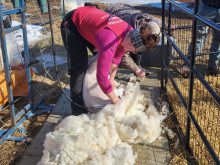A small plastic button no bigger than a loonie will soon deliver all the information anyone ever wanted to know about a single cow.
Starting Jan. 1, Canadian cattle will be identified with radio frequency button tags as part of an overall beef industry plan to improve individual identification and traceback of food animals.
The radio frequency tags, also referred to as electronic identification, will replace the bar coded plastic dangle tags.
“The transition is going over very effectively for the electronic identification,” said Chris Giffen of the Canadian Cattle Identification Agency, which approves the tags and manages the livestock database.
Read Also

Charges laid after cattle theft
Saskatchewan RCMP lay two charges against a man after six cattle went missing.
The federal and provincial government set-aside programs decided to use the button tags but they will have different coloured backs for sorting.
“The set-aside programs are run completely separate from the cattle identification program. They are just using the existing tags,” Giffen said.
Manufacturers and dealers are allowed to sell the bar coded plastic tags until July 2005. Producers who still have the old tags on hand may use them for a limited time.
“There are a number of the bar coded tags in the system, so we have to allow for the majority of those to get through the system before we have a cutoff,” he said.
The official tag has a yellow back with a visible 15 digit number and the agency logo. It can be electronically read with an RFID device so a producer can transfer information such as birth dates, weights, pregnancies and other relevant data quickly and accurately to his own computer, if desired. The signal can penetrate through wood, plastic, mud, manure and hair and can be read at a minimum distance of 25 centimetres.
The identification agency allocates specific sequences of numbers to manufacturers who write the individual number into each tag. The number can only be read from the tag and can never be changed. The numbers are ISO approved.
“If they are shipped anywhere in the world they’ll be able to recognize our number,” said Clay Ross of Allflex, which manufactures ear tags.
The tags contain a silicon chip and copper antennae. They are referred to as passive because they have no power of their own.
A special receiver awakens the embedded transponder. It sends a signal back to the transceiver that is connected to a computer or an electronic scale to record information for the producer’s records.
The tags sell for about $3 each.
The agency tested 70,000 tags in the field and found if they were applied according to manufacturer instructions, they held in the animal’s ear.
All approved tags are the button type but some dangle tags are under review. The agency should know within four or five months which are acceptable.
Reading stations have not been established but major packinghouses already have them. Auction yards will also likely have readers to record animal movement. Farmers are not expected to have electronic readers.
“The major packers across the country right now have been reading tags right from the beginning of the program,” said Giffen.
The tags are disposed of and numbers retired when the animal dies.
The Canadian Food Inspection Agency has used the identification program on different occasions to track animals back to herds of origin in case of disease or other problems.
The identification agency is also allowed to contact herds of origin when stray animals are found and brand inspectors cannot find the owners.
The agency has approved the following brand name tags: Allflex FDX, Allflex HDX, Destron Fearing etag FDX, Nedap D40 cattle tag FDX and Y-Tex TechStar II tag FDX.

















